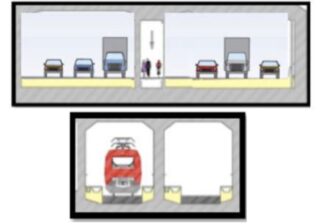
To Bob Ortblad, a retired civil engineer who lives in Seattle, the team behind the Interstate Bridge Replacement Program (IBRP) – the plan to expand I-5 bridge between Vancouver and Portland across the Columbia River – have it all wrong.
While other advocates have proposed alternatives to the highway expansion, like congestion pricing or a project that better incorporates public transit light light rail or even high speed rail, Ortblad has spent the last three years trying to convince planners to consider scrapping the bridge idea altogether, opting instead for an immersed tube tunnel (ITT).
But he says IBRP planners have tunnel vision when it comes to his immersed tunnel vision.
Ortblad’s case for a tunnel under the Columbia River revolves around safety, land use and environmental impact. He’s written dozens of letters and slideshow presentations explaining his reasoning, but says the IBR program team hasn’t given his idea the serious consideration it deserves.
“The people at the IBRP have been manufacturing consent for this bridge. It’s Kabuki theater.”
— Bob Ortblad, transportation advocate and retired engineer
According to Ortblad, who has been inspired by tunnels around the world, like the Hvalfjörður Tunnel in Iceland, which stretches about three and a half miles under a fjord, the Oresund Bridge & Immersed Tunnel connecting Sweden to Denmark and the Fort McHenry Tunnel carrying traffic on I-95 under the Baltimore Harbor.
As far as safety advantages, Ortblad gives two key considerations. First, bridges can be dangerous for people traveling across them via any means of transportation. In an August letter to the editor of The Columbian, Ortblad referenced the case of Antonio Amaro Lopez, who plunged off the I-205 Glenn Jackson Bridge across the Columbia River on Valentine’s Day last year (and whose family is now suing ODOT for negligence).
Ortblad says the I-205 bridge is dangerous enough, but the new I-5 Columbia River bridge, which has a 4 percent downgrade and shaded northern exposure retaining black ice, will be even more dangerous.
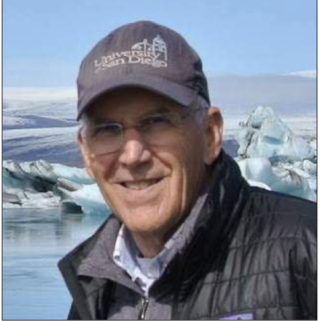
One reason planners cite the need to replace the I-5 bridge is the threat of earthquakes. Other projects are underway to replace bridges in the region for the purpose of earthquake-readiness, like the Earthquake Safe Burnside Bridge project, but Ortblad says a tunnel would be the better way to go for crossing the Columbia.
Some seismically active regions like the San Francisco Bay Area and the entire country of Japan, have implemented immersed tube tunnels which have held up through high-magnitude earthquakes. Ortblad points to the buoyancy of tunnels to explain their seismic resistance. If an earthquake happens, the thinking goes, tunnels are more flexible and can move with the ground instead of being tossed around by the shaking earth.
The ability to preserve land on Hayden Island and Vancouver’s waterfront is another reason Ortblad wants IBRP leaders to consider a tunnel. Replacing the I-5 bridge will require long, elevated concrete viaducts to lift traffic 100 feet or more up to the bridge, taking up a lot of room with on and off-ramps. A graphic Ortblad created (below) warns that leading IBRP designs would “dump acres of concrete on Vancouver’s waterfront.”
That elevation gain has also been raised as a concern for bicycle riders, who’ll have to pedal up it each time they cross the river. “Only the very fittest will be able to climb on a bicycle or on foot the 100-foot ascent (ten stories) needed to cross a new high bridge,” Ortblad shared with us after seeing preliminary bike plan designs from IBRP staff in December. “At age 75 and walking with a cane, you can count me out.”
Comparably, an underwater tunnel would be hidden from view – as would the noise its traffic would generate – and the ground-level entrance would make it easier for people to enter the tunnel. (Ortblad gestures to the Maastunnel in Rotterdam, Netherlands (shown above) as an example of a bikeable immersed tunnel.)
The IBR program team did an analysis of the immersed tunnel alternative and threw cold water on it. Why? According to the IBRP’s memorandum on its evaluation of the immersed tunnel alternative, it has “numerous challenges [which] demonstrate it is not a viable replacement solution for the IBR program.”
Advertisement
The IBRP team even went on the offensive against the tunnel idea on social media last month:
Why isn’t a tunnel a feasible solution for our program?
▪️It would eliminate important connections to Hayden Island, downtown Vancouver and SR-14.
▪️It would cost more than a replacement bridge.
▪️It comes with significantly more environmental impacts. pic.twitter.com/XosegjW6Sq
— IBRprogram (@IbrProgram) January 19, 2022
The stated challenges include “significant out-of-direction travel for drivers, freight, transit users, bicyclists and pedestrians; the inability to tie into existing connections such as SR 14, Vancouver City Center, and Hayden Island; safety concerns for bicyclists and pedestrians; and significant archaeological, cultural, and environmental impacts” as well almost double the cost.
But Ortblad says this analysis wasn’t done in good faith. To him, the IBRP administration is pushing through the 10-year-old CRC bridge design, the previous iteration of an I-5 replacement bridge, under a different name. This project was killed in 2013, which was a relief to environmental and bike activists who had advocated against it.
“The people at the IBRP have been manufacturing consent for this bridge,” Ortblad tells BikePortland. “It’s Kabuki theater.”
In an October letter to the editor at Clark County Today, Ortblad asks for this analysis to be retracted. He says WSP USA, IBRP’s engineering consulting group, has a conflict of interest in evaluating an immersed tube tunnel because it is “anticipating hundreds of millions in bridge design and construction management fees.”
Ortblad says the analysis evaluated an ITT under the current primary barge channel at the bridge lift by the Vancouver riverbank, when it should have evaluated a channel near the center of the river, which would have resulted in a more realistic and inexpensive tunnel design.
At an IBRP Equity Advisory Group meeting on Monday, project managers showed 10 potential new transit alignments for the bridge, most of which are light rail options. The light rail debate was a big part of the conflict that ultimately doomed the original CRC, so its inclusion is notable.
Ortblad says IBRP leaders haven’t given his tunnel idea the time of day, but he persists anyway, penning letters to politicians and the editors of Portland-Vancouver area newspapers. Having tried relentlessly to get IBRP administration’s attention, he has now moved on to try to get policymakers on board.
“I plan to share my advocacy and research with the United States Coast Guard, U.S. Corps of Engineers, Federal Highway Administration, Federal Transit Administration, U.S. Environmental Protection Agency, my elected representatives, community and business associations, and the press,” he wrote in a letter to Washington State Senator Marko Liias in January.
“Going under the river is a better solution than going over.”




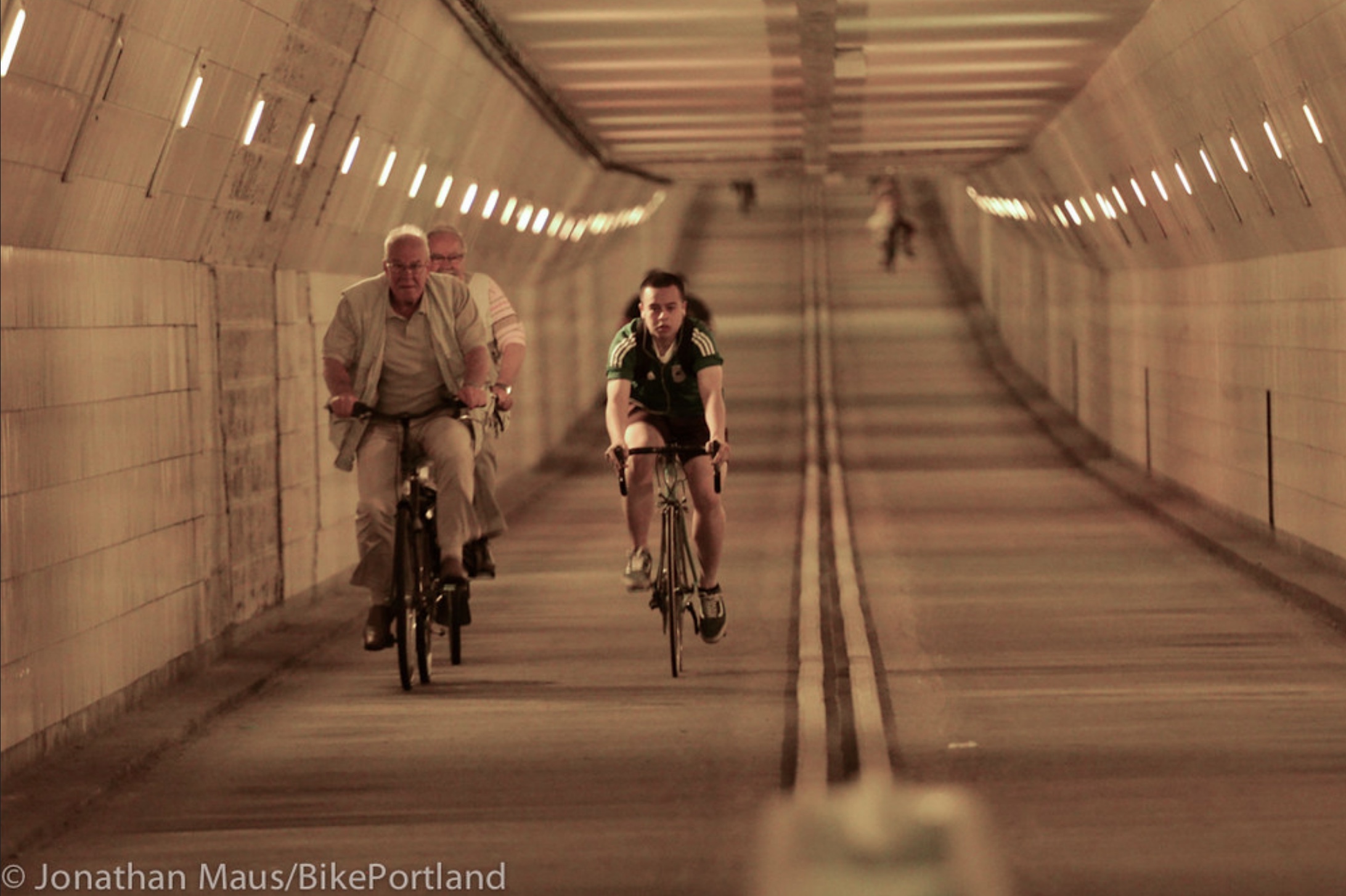

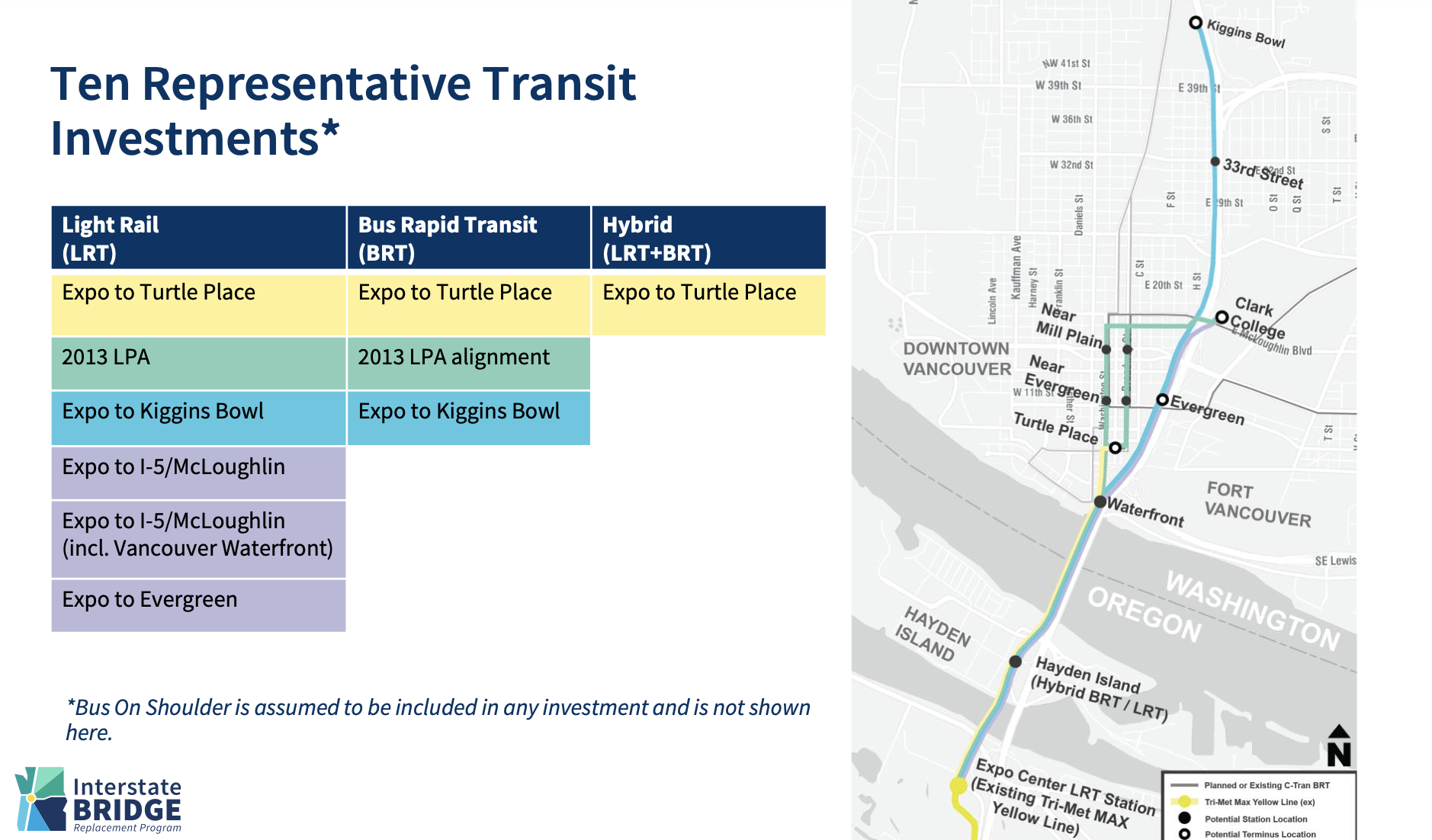


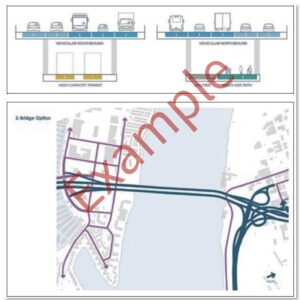

Thanks for reading.
BikePortland has served this community with independent community journalism since 2005. We rely on subscriptions from readers like you to survive. Your financial support is vital in keeping this valuable resource alive and well.
Please subscribe today to strengthen and expand our work.
No connection with SR-14 is a deal-breaker here. I suppose you could keep an SR-14 to I-5 northbound connection with a loop-back flyover just north of the north tunnel portal, but that seems like it would add a lot of expense. The connection to Marine Drive at the south end also needs to be maintained, but I think that could be done with a shallow tunnel.
Tunnel entrance would be near SR 500
Could the Interstate bridge somehow be “repurposed” to act as the on/off ramp for Hayden Island and SR-14?
The northbound bridge (the original 1918 span) certainly needs to go; it’s frankly a hazard at this point. But that’s an interesting idea: repurpose the 1958 southbound bridge for this purpose…
My understanding is that a tunnel wouldn’t meet the same level of service as a bridge which is what the lack of the same connections is about. Depending on the depth and grade not just downtown Vancouver could be cut off but also downtown Portland. Even if that scenario isn’t 100% true the few listed above are almost certainly unacceptable to WSDOT and ODOT.
The main issue with tunnels is that the cost is usually twice as high as a bridge at this length. A 1/2 mile long tunnel would also be unpleasant for bikes.
The cheaper, better solution is to repair the 1958 span for local car traffic, replace the 1918 span with a local bridge for transit and bikes, remove the interchange on Hayden island, and build a new mid-level bridge for transit, bikes, pedestrians and local access to Hayden Island. This will remove most of the impact of the highway from the island and provide better access at lower cost. This is similar to the “Common Sense Alternative” presented in 2013 – it also includes a new lift span for the nearby railway bridge to avoid most bridge lifts. https://www.aortarail.org/site/assets/files/13735/common_sense_alternative_ii_3_2021-05-28.pdf
You can also do this with a wider new span, if ODOT insists.
Cyclists complain about riding the I-205 path between the travel lanes without a glimpse of the river. How would you like riding in a tunnel for 15 minutes?
15 mins to ride 1/2 a mile?
To go beneath the river, the tunnel is going to have to start down at Mill Plain at the north and come to the surface at Victory interchange to the south. That’s about 3 miles. Yep. About 15 minutes.
Good point, yes…a tunnel ride would loose the ‘sunsets’ but it should be much quieter, cleaner air and flatter from the bike tunnels in Europe I have ridden through.
Quiet, cleaner air, and flat? You have to be kidding. There will need to be massive, noisy fans to exhaust the air from the tunnel. To accommodate air movement, there will be cross ventilation among the tunnels serving the different mode so you’re not going to get away from the noise of traffic or the exhaust fans. The primary reason to expect it to be flatter than those in Europe is to make sure it’s ADA compliant with long ramps. Unless, of course, you favor elevators. The tunnels I’ve biked in France were converted RR grades, which are pretty gentle grades. I don’t know about any steep ones.
The diagrams shows just a concept. There’s no provision for drainage. There’s nothing shown for all the infrastructure such as lighting, ventilation, or emergency access. Even the electrified rail tunnel will need forced ventilation. Running a train through a tunnel is no where near enough for ventilation. Plus, the diagram doesn’t even provide full-width shoulders and what is shown is only on one side.
The three mile long Robertson tunnel on the MAX Blue Line has fans for emergency ventilation, but they are only operated for testing. Train movement and/or convection are sufficient, unless there is a fire. The three mile Berkeley Hills on BART likewise has fans that are only used for testing and emergency use.
The Robertson tunnel slopes down from W to E at all points, the grade changes but there is no dip that would hold a pocket of cooler air. Any wind (pressure difference) or temperature difference between the ends operates to move air through it. There’s an elevation change of about 400 feet from one end to the other.
A tunnel under the Columbia would have a dip in the middle, with both ends at about the same elevation.
Thanks Bob Ortblad (and Taylor Griggs) for resurrecting this topic.
Bob, you are going to need to coordinate with the Portland area folks to do a roadshow in this region with someone authoritative that worked on a similar tunnel project, perhaps with Seattle’s recent tunnel. (Sadly, I doubt anyone from WSDOT would volunteer to do it…just to not ruffle the ODOT highway folks.) Plus there may need to be legal action to make ODOT / WSDOT hire an independent resource to investigate this design question…sooner than later.
I’m skeptical of the value of a tunnel, but he’s absolutely right: the IBRP staff are no more willing to analyze this alternative in good faith than any of the other reasonable alternatives that they have rejected out of hand. This entire process is just a revival of the CRC megaproject. They couldn’t even be bothered to file off the serial numbers.
Here’s what I concluded about the Tunnel Option in 2005 after the completion of my time on the Governors’ I-5 Task Force:
The Tunnel option simplifies construction logistics, has fewer impacts on river traffic, water quality, fish or air traffic. The conversion of the existing Interstate Bridges, retains historic structures, re-using them in new ways to accommodate local vehicle and transit trips. Removal/conversion of existing freeway segments captures valuable land adjacent to transit, arterials and the River for re-development…commercial, industrial or residential/retail.
Interstate Bridge can’t last forever, but every design is fraught and any attempt to replace it seems to fail. The latest is that Republicans in Salem are threatening to shut it down again if a fuel export tax passes in Olympia, so let’s stay tuned.
For my part, I would prefer the high bridge instead of a three mile tunnel, but at the current rate we’ll have a ferry out of necessity.
Serious questions: who is the user that needs such high bridge clearance, and are they really too big and expensive to buy out but also small enough to navigate the locks at Bonneville Dam?
Just please don’t tell us the bridge needs to be that high so bezos’ yacht will clear it.
Oregon Steel, Schnitzel Steel, and one other heavy industrial company at the Vancouver industrial park opposite Vancouver’s Blanford drive. They’re major manufacturing, building BART segments and offshore drilling equipment for Alaska ‘s North Slope
The IBRP tunnel analysis was clearly done in bad faith because it assumes a main shipping channel along the north bank of the river. This affects the grades and what is possible with roadway connections in Washington. It has long been Coast Guard policy that the channel should be moved to the center of the river when possible. If given funding, the Coast Guard has authority to order and fund a replacement for the railroad swing span immediately downstream, which, along with the existing I-5 bridges, is the reason for the current channel location. The IBRP refuses to analyze fixing the railroad bridge as a component of their project. The tunnel deserves a fair analysis, as do other proposals such as the Common Sense Alternative version II https://aortarail.org/issues/ which the IBRP claims to have studied, but in fact they did not ever study it.
The tunnel in Rotterdam looks great on youtube. Do you know if they have challenges regarding maintenance, operations, accessibility and security? A long tunnel like this would be a non-starter to many people cycling and walking in this community.
I’ll just leave this here
https://www.tripadvisor.com/Attraction_Review-g303160-d2172378-Reviews-Kammon_Highway_Tunnel-Kitakyushu_Fukuoka_Prefecture_Kyushu.html
added perspective:
https://www.clarkcountytoday.com/news/will-the-interstate-bridge-replacement-become-another-bridge-too-low/
Mr Ortblad has many tunnel proposals.
https://wstc.wa.gov/wp-content/uploads/2019/11/2018-0417-BP2-CrossSoundTravel.pdf